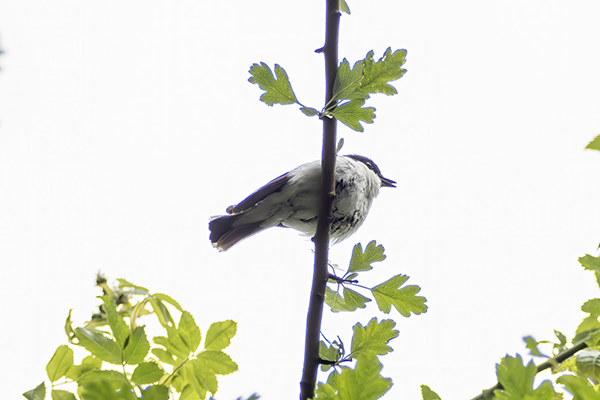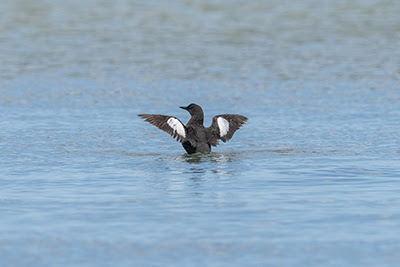I started this blog in 2008 primarily as a vehicle to record my birding trips so, in old age when memories fail, I had some thing to look back on and remind me of the incredible adventures I've had over the years with some good mates. I've already written about our first trip to Shetland in spring 2007 for Killdeer and how we went back again in September here. This post carries on from where I left off with a trip to Fetlar and Foula.
With Jason, Al and Malc we'd arrived on Shetland a few days previously and were staying at Hoswick. A busy few days had us touring the mainland mopping up a few species the guys needed for their year lists.
 |
| Spot the real scarecrows |
It was the 28th September and we'd been watching an elusive female Sardinian Warbler at Spiggie and I was chatting to the owner of the garden the bird frequented (who'd had kindly allowed us to view from inside the garden) when one of the local birders told us about a Swainsons Thrush that had just been found on Fetlar. Given that it was several hours and three islands away involving two ferries and a long drive we were advised to leave immediately if we wanted to see it that day. What we didn't realise as we set off was that a 1st winter mle Siberian Thrush had just been found on Foula and the locals had all chartered a flight - in those days, pre- AirTask, inter island flights could be chartered if there was enough interest. We had no chance of getting on that flight so carried on to Fetlar. Jason contacted Jon Dunn on Whalsay who gave us the name of a boat skipper who'd be willing to take us to Foula the next day and could take 14 people. Putting a message out through Rare Bird Alert (RBA) he filled the boat within minutes and we agreed to meet the skipper in Lerwick early the next morning.
 |
| Jase, Al & me on inter island ferry to Fetlar. Note the binoculars of preference in those days were Leica's |
 |
| Me, Jase, Al & Malc on Fetlar |
Arriving at Fetlar we drove the short distance to Houbie and parked at the interpretive centre before strolling up the hill towards the community hall. We weren't quite sure where we were going as the message was rather vague as to where the bird was stating only that it was ' along the road towards the community hall'.
As usual Al was strolling along fag in hand when he suddenly announced he'd got it. The Swainsons Thrush had literally hopped on the wall in front of him before landing in an adjacent field.
We enjoyed watching this American
catharus thrush as it foraged in fields along the road until it flew down hill and out of sight. With time pressing we went back towards the car taking in a Red- backed Shrike in the gardens of Leagarth House and a wander up Feal Burn for a Blyth's Reed Warbler.
The next day was the big boat trip to Foula and all the guys making the trip met up in Lerwick for a cooked breakfast before embarking on our transport for the day the 'Marie Rose' skippered by the indomitable Davey. Joining us that day were Stu Piner (of RBA), John Bell and Pierre-Andre Crochet with another french birder. News wasn't looking good with local on Foula reporting there was no sign by the time we left. Knowing how elusive Siberian Thrushes can be we weren't unduly worried......
Three hours later we arrived for our 1st visit to Foula. Skipper Davey gave us a time to be back at the quay and we split up and headed off in different directions looking for the elusive Sibe. Nothing, zilch. All we had for our efforts were several Yellow-browed Warblers, a Snow Bunting and a flyover Citrine Wagtail that Al & I followed until it landed and got brief views before it took off again.
Despondent we trudged back to the quay to find our skipper had laid on cheese and biscuits for us aboard the Marie Rose! Not only that but it was his last charter of the year and he had an immense quantity of spirits and beers that needed to be drunk.....
The weather was beautiful with calm sea and blue skies. Davey asked if we wanted some music and proceeded to put on a CD (!) of Scottish reel music as we hurtled along with a creamy white wake behind us. Spotting a fishing boat, being followed by a number of seabirds, he took us alongside where we enjoyed good views of Blue Fulmar and Sooty Shearwater whilst he yelled abuse at the crew of the other boat who he obviously knew well. It was all getting quite surreal.
News came through that the Killdeer we'd seen in the spring had been re-found on the Pool of Virkie so Al asked Davey to drop him off at Grutness as he wasn't with us in the spring. We carried onto Lerwick making sure we demolished the rest of the free drinks on offer. Apparently it was all going to be poured down the drain if we didn't drink it. It was a slightly tipsy but happy crew that disembarked and went our separate ways. Jason, our designated driver, had remained sober and drove us towards Geosetter where a Red-breasted Flycatcher had been located before heading south to pick Al up.
What followed has been the subject of years of ribbing. Whilst searching the burn at Geosetter I tripped and somehow my old Nokia 3310 phone got dislodged from my pocket never to be seen again. Its still there somewhere. Luckily I still had my works Blackberry personal organiser which, back then, were all the rage for business use as they were able to send and receive emails as well as make calls!
Jase took a phone call from a slightly inebriated Al asking how long we were going to be. It turned out he'd got lost and ended up walking along the runway at Sumburgh in his attempt to get to the Pool of Virkie and was picked up by an airline stewardess who kindly dropped him off at the correct place. He then cadged a lift to the off licence by Mainlands Mini market at Dunrossness. By this time it was late afternoon and all the shops shut at 4 pm on Saturday but he knocked on the door of the store and persuaded the woman to sell him 4 cans of Stella and a pack of cigarettes. When we finally met up with him we found him sharing a can of Stella with the stores owner on the doorstep......
A great trip and the first of many autumn visits to Shetland which has got noticeably busier over the years as other birders recognise the islands as rarity magnets.






























































































